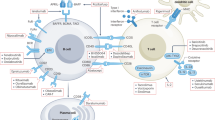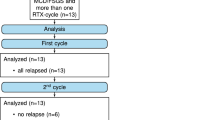Abstract
The introduction of new therapeutic modalities, such as biologic agents, for the treatment of lupus nephritis has re-energized research into this disorder, enabling investigators to formulate evidence-based recommendations. Thus, it is now widely accepted that the management of lupus nephritis involves a period of intensive induction therapy, followed by a longer period of less-intensive maintenance therapy. Risk stratification, based on histologic, demographic, clinical and laboratory characteristics, allows the identification of patients at high risk of renal dysfunction, for whom aggressive therapy is likely to be the most beneficial. New studies and meta-analyses comparing mycophenolate mofetil with cyclophosphamide have confirmed the efficacy of the former for induction and maintenance therapy—particularly induction therapy, owing to its favorable toxicity profile; however, claims of efficacy superior to that of cyclophosphamide require additional documentation. Nonetheless, an increasing number of physicians use mycophenolate mofetil as induction therapy for most cases of proliferative lupus nephritis, while reserving cyclophosphamide for the most severe cases. No evidence yet indicates that mycophenolate mofetil is better than azathioprine for the maintenance of remission. For patients who relapse or who are unable to be treated with these agents, rituximab seems to offer some benefit with an acceptable toxicity profile. This article summarizes the advances in the management of lupus nephritis since our 2005 Review.
Key Points
-
The treatment of lupus nephritis involves a period of intensive induction therapy, followed by a longer period of less-intensive maintenance therapy
-
Combinations of intravenous cyclophosphamide and methylprednisolone are effective for the induction and maintenance of remission in patients with severe lupus nephritis
-
Mycophenolate mofetil is an acceptable option for the induction of remission in moderately severe lupus nephritis
-
Mycophenolate mofetil or azathioprine could also be used as a maintenance therapy following cyclophosphamide induction therapy
-
In addition to immunosuppressive therapy, aggressive treatment of hypertension and hyperlipidemia is essential
-
For patients with established chronic kidney disease (estimated glomerular filtration rate <60 ml/min or stable proteinuria more than 0.5 g per day), renoprotective therapy with angiotensin-converting-enzyme inhibitors and/or angiotensin-receptor blockers is recommended
This is a preview of subscription content, access via your institution
Access options
Subscribe to this journal
Receive 12 print issues and online access
$209.00 per year
only $17.42 per issue
Buy this article
- Purchase on Springer Link
- Instant access to full article PDF
Prices may be subject to local taxes which are calculated during checkout

Similar content being viewed by others
References
Boumpas DT et al. (1992) Controlled trial of pulse methylprednisolone versus two regimens of pulse cyclophosphamide in severe lupus nephritis. Lancet 340: 741–745
Gourley MF et al. (1996) Methylprednisolone and cyclophosphamide, alone or in combination, in patients with lupus nephritis. A randomized, controlled trial. Ann Intern Med 125: 549–557
Illei GG et al. (2001) Combination therapy with pulse cyclophosphamide plus pulse methylprednisolone improves long-term renal outcome without adding toxicity in patients with lupus nephritis. Ann Intern Med 135: 248–257
Boumpas DT et al. (1993) Risk for sustained amenorrhea in patients with systemic lupus erythematosus receiving intermittent pulse cyclophosphamide therapy. Ann Intern Med 119: 366–369
Houssiau FA et al. (2004) Early response to immunosuppressive therapy predicts good renal outcome in lupus nephritis: lessons from long-term followup of patients in the Euro-Lupus Nephritis Trial. Arthritis Rheum 50: 3934–3940
Boumpas DT et al. (2005) Optimum therapeutic approaches for lupus nephritis: what therapy and for whom? Nat Clin Pract Rheumatol 1: 22–30
Grootscholten C et al. (2006) Azathioprine/methylprednisolone versus cyclophosphamide in proliferative lupus nephritis. A randomized controlled trial. Kidney Int 70: 732–742
Grootscholten C et al. (2007) Treatment with cyclophosphamide delays the progression of chronic lesions more effectively than does treatment with azathioprine plus methylprednisolone in patients with proliferative lupus nephritis. Arthritis Rheum 56: 924–937
Mok CC et al. (2006) Long-term outcome of diffuse proliferative lupus glomerulonephritis treated with cyclophosphamide. Am J Med 119: e25–e33
Moore RA and Derry S (2006) Systematic review and meta-analysis of randomised trials and cohort studies of mycophenolate mofetil in lupus nephritis. Arthritis Res Ther 8: 1–10
Walsh M et al. (2007) Mycophenolate mofetil for induction therapy of lupus nephritis: a systematic review and meta-analysis. Clin J Am Soc Nephrol 5: 968–975
Zhu B et al. (2007) Mycophenolate mofetil in induction and maintenance therapy of severe lupus nephritis: a meta-analysis of randomized controlled trials. Nephrol Dial Transplant 22: 1933–1942
A study of CellCept (mycophenolate mofetil) in management of patients with lupus nephritis. [http://clinicaltrials.gov/ct/show/NCT00121082] (accessed 17 July 2008)
Ginzler E. et al. (2007) Mycophenolate mofetil and intravenous cyclophosphamide in the Aspreva Lupus Management Study (ALMS): efficacy by racial group. Presented at the American College of Rheumatology Annual Meeting, 2007, Boston, MA [www.rheumatology.org]
Moroni G et al. (1996) “Nephritic flares” are predictors of bad long-term renal outcome in lupus nephritis. Kidney Int 50: 2047–2053
Illei GG et al. (2002) Renal flares are common in patients with severe proliferative lupus nephritis treated with pulse immunosuppressive therapy: long-term followup of a cohort of 145 patients participating in randomized controlled studies. Arthritis Rheum 46: 995–1002
Chan TM et al. (2005) Long-term outcome of patients with diffuse proliferative lupus nephritis treated with prednisolone and oral cyclophosphamide followed by azathioprine. Lupus 14: 265–272
Moroni G et al. (2006) A randomized pilot trial comparing cyclosporine and azathioprine for maintenance therapy in diffuse lupus nephritis over four years. Clin J Am Soc Nephrol 1: 925–932
Chan TM et al. (2005) Long-term study of mycophenolate mofetil as continuous induction and maintenance treatment for diffuse proliferative lupus nephritis. J Am Soc Nephrol 16: 1076–1084
Contreras G et al. (2004) Sequential therapies for proliferative lupus nephritis. N Engl J Med 350: 971–980
Gottenberg JE et al. (2005) Tolerance and short term efficacy of rituximab in 43 patients with systemic autoimmune diseases. Ann Rheum Dis 64: 913–920
Gunnarsson I et al. (2007) Histopathologic and clinical outcome of rituximab treatment in patients with cyclophosphamide-resistant proliferative lupus nephritis. Arthritis Rheum 56: 1263–1272
Looney RJ et al. (2004) B cell depletion as a novel treatment for systemic lupus erythematosus: a phase I/II dose-escalation trial of rituximab. Arthritis Rheum 50: 2580–2589
Ng KP et al. (2007) B cell depletion therapy in systemic lupus erythematosus: long-term follow-up and predictors of response. Ann Rheum Dis 66: 1259–1262
Sfikakis PP et al. (2005) Remission of proliferative lupus nephritis following B cell depletion therapy is preceded by down-regulation of the T cell costimulatory molecule CD40 ligand: an open-label trial. Arthritis Rheum 52: 501–513
Smith KG et al. (2006) Long-term comparison of rituximab treatment for refractory systemic lupus erythematosus and vasculitis: remission, relapse, and re-treatment. Arthritis Rheum 54: 2970–2982
Tanaka Y et al. (2007) A multicenter phase I/II trial of rituximab for refractory systemic lupus erythematosus. Mod Rheumatol 17: 191–197
Vigna-Perez M et al. (2006) Clinical and immunological effects of rituximab in patients with lupus nephritis refractory to conventional therapy: a pilot study. Arthritis Res Ther 8: R83
Genentech Inc. website [http://www.gene.com/gene/news] (accessed 17 July 2008)
A study to evaluate the efficacy and safety of rituximab in patients with severe systemic lupus erythematosus (EXPLORER) [http://clinicaltrials.gov/ct/show/NCT00137969] (accessed 17 July 2008)
Study to evaluate the efficacy and safety of rituximab in subjects with ISN/RPS class III or IV lupus nephritis (LUNAR) [http://clinicaltrials.gov/ct/show/NCT00282347] (accessed 17 July 2008)
Ogawa H et al. (2007) Prospective study of low-dose cyclosporine A in patients with refractory lupus nephritis. Mod Rheumatol 17: 92–97
Mok CC et al. (2005) Tacrolimus for induction therapy of diffuse proliferative lupus nephritis: an open-labeled pilot study. Kidney Int 68: 813–817
Mok CC et al. (2004) Treatment of pure membranous lupus nephropathy with prednisone and azathioprine: an open-label trial. Am J Kidney Dis 43: 269–276
Moroni G et al. (1998) Treatment of membranous lupus nephritis. Am J Kidney Dis 31: 681–686
Spetie DN et al. (2004) Mycophenolate therapy of SLE membranous nephropathy. Kidney Int 66: 2411–2415
Austin H et al. (2004) Lupus membranous nephropathy: controlled trial of prednisone, pulse cyclophosphamide and cyclosporine A [abstract]. J Am Soc Nephrol 15: 54A
Kapitsinou PP et al. (2004) Lupus nephritis: treatment with mycophenolate mofetil. Rheumatology (Oxford) 43: 377–380
Karim MY et al. (2005) Reduction of proteinuria with mycophenolate mofetil in predominantly membranous lupus nephropathy. Rheumatology (Oxford) 44: 1317–1321
Borba EF et al. (2006) Mycophenolate mofetil is effective in reducing lupus glomerulonephritis proteinuria. Rheumatol Int 12: 1078–1083
Tse KC et al. (2007) A pilot study on tacrolimus treatment in membranous or quiescent lupus nephritis with proteinuria resistant to angiotensin inhibition or blockade. Lupus 16: 46–51
Nikpour M et al. (2005) Premature atherosclerosis in systemic lupus erythematosus. Rheum Dis Clin North Am 31: 329–354
Bertsias GK et al. (2008) EULAR recommendations for the management of systemic lupus erytematosus. Report of a Task Force of the EULAR Standing Committee for International Clinical Studies Including Therapeutics. Ann Rheum Dis 67: 195–205
Author information
Authors and Affiliations
Corresponding author
Ethics declarations
Competing interests
The authors declare no competing financial interests.
Rights and permissions
About this article
Cite this article
Bertsias, G., Boumpas, D. Update on the management of lupus nephritis: let the treatment fit the patient. Nat Rev Rheumatol 4, 464–472 (2008). https://doi.org/10.1038/ncprheum0896
Received:
Accepted:
Issue Date:
DOI: https://doi.org/10.1038/ncprheum0896
This article is cited by
-
Anti-inflammatory activities of Ganoderma lucidum (Lingzhi) and San-Miao-San supplements in MRL/lpr mice for the treatment of systemic lupus erythematosus
Chinese Medicine (2016)
-
Allogeneic mesenchymal stem cell transplantation for lupus nephritis patients refractory to conventional therapy
Clinical Rheumatology (2014)
-
Lupus Nephritis: Review of the Literature
Current Allergy and Asthma Reports (2013)
-
Simultaneous Positivity for Anti-DNA, Anti-Nucleosome and Anti-Histone Antibodies is a Marker for More Severe Lupus Nephritis
Journal of Clinical Immunology (2013)
-
Diagnosis and treatment of lupus nephritis flares—an update
Nature Reviews Nephrology (2012)



